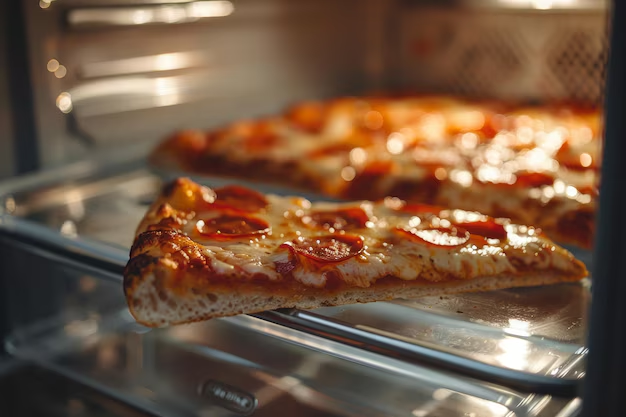How Fresh is Your Slice? Understanding Pizza’s Refrigerator Lifespan
When it comes to culinary indulgence, few foods captivate the heart like pizza. Whether it's a simple Margherita or a complex gourmet creation, pizza rarely disappoints. However, what happens when the feast ends and leftovers beckon from the refrigerator? How long can you safely savor that slice? This is a question of both practical interest and food safety. 🔍
The Shelf Life of Refrigerated Pizza
Understanding the Basics
Pizza, like all food, is best when fresh. However, life often interrupts our plans, leaving us with unfinished pies. Once placed in the refrigerator, pizza should maintain its quality for 3 to 4 days. Beyond this period, it isn't just the texture or taste that might suffer; food safety becomes a concern.
Factors Influencing Freshness
Several elements determine how long your pizza will last:
- Toppings: Meats and dairy products tend to spoil faster than plain cheese or vegetable pizzas.
- Storage Method: Properly sealed containers or tightly wrapped pizza will last longer than slices exposed to air.
- Initial Quality: The freshness of the ingredients at the time of making impacts how long they remain safe to consume.
Proper Storage Techniques
Wrapping It Right
When storing pizza, wrap each slice tightly in plastic wrap or aluminum foil. This not only preserves moisture but also limits exposure to air, which is a key factor in food spoilage.
The Airtight Advantage
Using airtight containers provides a double benefit by protecting the pizza from drying out and guarding against bacteria. If stacking slices, place parchment paper between them to prevent sticking. 🥡
Temperature is Key
Keep your refrigerator at or below 40°F (4°C). This temperature inhibits bacterial growth and prolongs freshness. Consider a thermometer fridge to ensure consistent temperature.
Recognizing Spoiled Pizza
Even with the best storage techniques, pizza will eventually go bad. Here’s what to look for:
- Mold: Any sign of mold means the pizza has spoiled and should be discarded immediately.
- Odor: A sour or off smell is a clear indicator that the pizza is no longer safe to eat.
- Texture: If the crust is overly dry or the toppings are slimy, it’s time to let go.
Health Risks of Consuming Spoiled Pizza
Consuming spoiled pizza can lead to foodborne illnesses, commonly known as food poisoning. Symptoms of food poisoning often include nausea, vomiting, diarrhea, and abdominal cramps. These arise from bacteria like Salmonella and Listeria, which can proliferate in improperly stored food. 🦠
Freezing Pizza for Longer Storage
When a three-to-four-day timeframe isn’t feasible, freezing pizza is a great alternative. Properly stored, frozen pizza can last for 1 to 2 months. Wrap slices tightly in plastic wrap, then foil, or use freezer bags. To reheat, use the oven or toaster oven instead of a microwave to maintain texture and flavor.
A Closer Look: Homemade vs. Store-Bought Pizza
Differing Durability
Homemade pizzas often have a longer fridge shelf life due to the absence of preservatives that are present in many store-bought versions. However, this also means they can spoil just as quickly if not stored properly.
Ingredient Influence
Homemade pizzas, made from fresh, high-quality ingredients, can last as long as their store-bought counterparts in the fridge if stored correctly. However, the initial ingredient freshness heavily influences this.
Keeping It Safe: Quick Tips 🛡️
Here's a handy bullet-point summary to keep your pizza both tasty and safe:
- 🧊 Refrigerate Quickly: Store pizza within 2 hours of cooking.
- 📦 Use Airtight Containers: Prolong shelf life by limiting exposure to air.
- ❌ Discard After 4 Days: When in doubt, throw it out!
- 🥶 Freeze for Extended Storage: Store for up to 2 months when frozen.
- 🔥 Reheat Thoroughly: Bring the internal temperature to at least 165°F (74°C) before eating.
Exploring Pizza from Different Angles
Culinary Creativity
Leftover pizza is incredibly versatile. Consider turning it into a new dish, such as a pizza omelet or pizza-stuffed peppers. Creativity not only reduces waste, it refreshes your meals.
Nutritional Considerations
Keep in mind the nutritional content when consuming leftover pizza. It can be higher in calories, fats, and sugars, emphasizing the importance of moderation.
A Final Slice of Wisdom
Knowing how to store and identify the freshness of your pizza means you can indulge without worries. With the right storage techniques and awareness, you not only safeguard flavor but also prevent potential health risks. 🍕 Embrace these guidelines to ensure each bite is deliciously safe, and remember, when in doubt, it’s better to err on the side of caution.
Is it time to revisit those slices in the fridge now? Check, savor, and enjoy responsibly. Bon Appétit!
